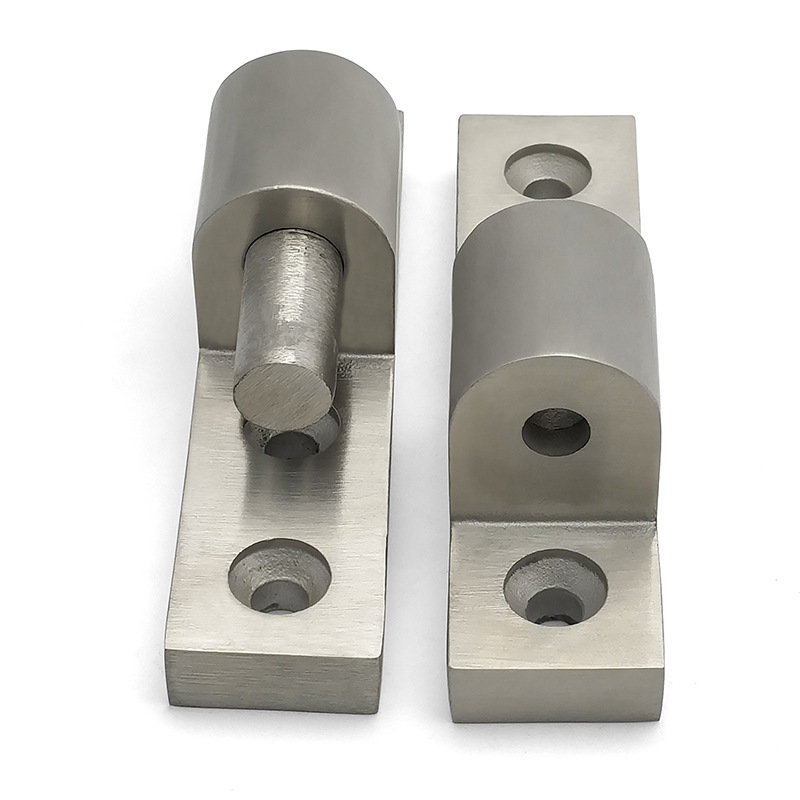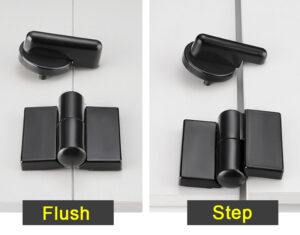Detachable cabinet hinges play a vital role in the industrial sector, providing a secure and flexible solution for gates. Understanding the definition and importance of these hinges is crucial in optimizing gate functionality within industrial environments. These hinges differ from commercial cold storage room hinges in that they are removable or concealment mounted.

Types of Detachable Cabinet Hinges
Barrel Hinges
Barrel hinges, known for their cylindrical design, offer exceptional durability and stability. They feature a unique working mechanism with a pin that rotates within a barrel, allowing smooth gate movement. These hinges find widespread applications in the industrial sector, particularly in heavy-duty gates where robustness is essential.
Strap Hinges:
Strap hinges are characterized by their long, flat straps that attach to both the gate and the post or frame. With their sturdy construction and reliable working mechanism, strap hinges provide excellent support and stability to industrial gates. Their applications range from large warehouse gates to industrial machinery enclosures, where durability is paramount.
Piano Hinges:
Piano hinges, often referred to as continuous hinges, are long, narrow hinges that run the entire length of the gate. Their continuous design ensures strength and stability, making them ideal for heavy industrial gates that require uninterrupted support. These hinges are commonly utilized in manufacturing plants, loading docks, and other industrial settings.
Weld-on Hinges:
Weld-on hinges are specifically designed for welding onto metal gates or frames. They offer a secure and permanent attachment, ensuring gate stability in demanding industrial environments. Weld-on hinges are widely used in applications such as access control gates, perimeter security fences, and industrial equipment enclosures.

Benefits of Detachable Cabinet Hinges in Industrial Applications
Enhanced Security and Safety:
Detachable cabinet hinges significantly improve security by providing a robust connection between the gate and the frame. Their sturdy construction and tamper-resistant features enhance the overall integrity of industrial gates, safeguarding valuable assets and ensuring a controlled environment. In high-security facilities like manufacturing plants and data centers, these hinges are instrumental in preventing unauthorized access.
Ease of Maintenance and Repair:
One of the notable advantages of detachable cabinet hinges is their ease of maintenance. When maintenance or repairs are required, these hinges can be easily detached, allowing quick access to the gate or surrounding equipment. This convenience reduces downtime in industrial operations, ensuring continuous productivity and minimizing disruptions to workflow.
Flexibility and Adjustability:
Detachable hinges enable flexibility in gate positioning, allowing adjustments as needed. In certain industrial applications, such as loading bays or warehouse areas, gate alignment and clearance may need to be modified based on specific requirements. Detachable hinges offer the ability to reposition gates or make alterations easily, ensuring optimal functionality and adaptability to changing circumstances.
Factors to Consider When Choosing Detachable Cabinet Hinges
Load-Bearing Capacity:
Selecting hinges with appropriate load-bearing capacity is crucial to ensure gate stability and longevity. Understanding the weight requirements of the gate and considering factors like heavy usage, wind load, and impact is essential when choosing suitable hinges. Proper load-bearing capacity ensures that the hinges can withstand the forces exerted on the gate, maintaining its structural integrity.
Material and Durability:
Hinge materials play a vital role in determining their durability and resistance to environmental factors. Exploring different materials, such as stainless steel, brass, or heavy-duty alloys, allows for informed decision-making based on the specific industrial environment. Considering factors like corrosion resistance, wear resistance, and temperature variations helps select hinges that can withstand harsh conditions and extended usage.
Environmental Considerations:
Industrial environments often expose cabinet hinges to challenging conditions, including moisture, extreme temperatures, and corrosive elements. Choosing hinges with appropriate resistance to these environmental factors is essential for long-term performance. Assessing the specific environmental conditions within the industrial sector, such as chemical exposure or outdoor elements, enables the selection of hinges that can withstand the challenges posed by the environment.

Installation and Maintenance Tips for Detachable Cabinet Hinges
Proper Installation Techniques
- Begin by aligning the gate and frame to ensure a precise fit.
- Mark the hinge locations and pre-drill holes for accurate placement.
- Attach the hinges securely using appropriate fasteners or welding techniques, depending on the hinge type.
- Verify smooth gate movement and make any necessary adjustments before finalizing the installation.
Regular Maintenance Practices
- Conduct routine inspections of hinges, looking for signs of wear, damage, or misalignment.
- Lubricate the hinges periodically with high-quality industrial lubricants to minimize friction and ensure smooth operation.
- Clean the hinges and surrounding areas to remove debris, dirt, and contaminants that could affect their performance.
- Address any identified issues promptly to prevent further damage and ensure the longevity of the cabinet hinges.
Conclusion
Detachable cabinet hinges offer a valuable solution in industrial applications, enhancing security, flexibility, and ease of maintenance. By understanding the various hinge types, considering essential factors during selection, and following proper installation and maintenance practices, industrial professionals can optimize gate functionality, ensuring reliable and secure access control. The adaptability and durability of detachable cabinet hinges make them an indispensable component in industrial settings, contributing to efficient operations and enhanced safety.







